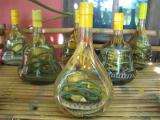Today was our first day of “vacation” after trekking through busy airports, world-famous museums, bustling cities and ancient ruins for almost a month. Last night we landed in Dahab and today Tina completed her first two open water ocean dives. She’s a natural in the water! 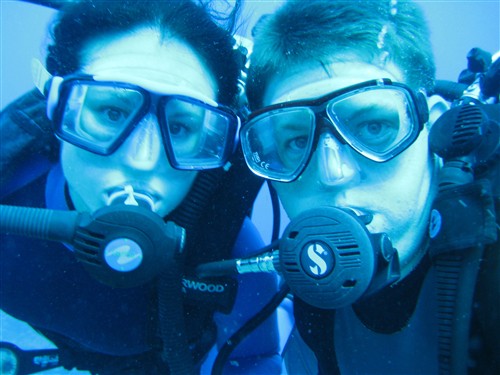
Archive for September, 2007
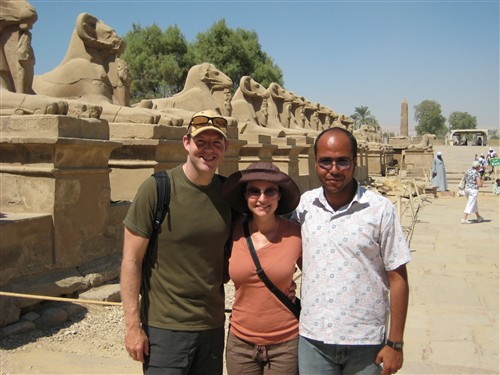 Archeologists and historians would no doubt argue that Luxor was one of the greatest ancient cities and the sheer number of temples, tombs, and ruins that remain provide unprecedented insight into the rise and fall of ancient Egypt. The remains of this once-great city have created a Mecca of Egyptology but to experience this history, travelers must endure the present-day city. Luxor is very small in comparison to Cairo and is actually made up of three separate areas: Luxor town, Karnak on the East Bank, and Thebes on the West.
Archeologists and historians would no doubt argue that Luxor was one of the greatest ancient cities and the sheer number of temples, tombs, and ruins that remain provide unprecedented insight into the rise and fall of ancient Egypt. The remains of this once-great city have created a Mecca of Egyptology but to experience this history, travelers must endure the present-day city. Luxor is very small in comparison to Cairo and is actually made up of three separate areas: Luxor town, Karnak on the East Bank, and Thebes on the West.
We spent our first two days in Luxor touring ruins with Mohammed. On the West Bank, we saw the Valley of the Kings, Valley of the Queens and Temple of Hatshepsut. The Valley of the Kings contains sixty-two tombs of ancient kings; each tomb consists of three to five rooms, etched and painted with stories of the deceased slaying his enemies, making offerings to the Gods, and traveling into the Afterlife. The Valley of the Queens is similar, though smaller in scale, and contains the tombs of the sons of Ramses III, who both appear to have died at an early age because they are portrayed as children. Upon arrival you see why this place was so sacred to the Pharaohs. The lush green landscape, with thousands of date palms and fields filled with sugar cane, magically connects the Nile with the mountain range near the West Bank. As we drive, we spy farmers tending their crops unfazed by the sweltering morning sun. Goat herders guide their flock along busy thoroughfares oblivious to the hazard they present to passing motorists. Barricades slow traffic and provide checkpoints for the Antiquities Police charged with guarding tourist safety in between their frequent naps.
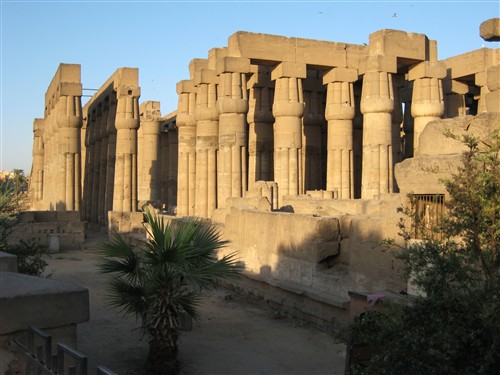 Arriving at each of our appointed destinations, we are greeted by rows of tour buses, all picking up or dropping off their cargo. We’re thankful for the privacy of our small entourage but we still are subjected to the touring masses in huge groups all pushing their way through the (insert featured attraction here) for a quick (often forbidden) picture of the claustrophobic tombs and narrow temple passageways. The oppressive heat of Upper Egypt penetrates the mind, body and spirit, invoking a mind-blurring sense of weariness. The history imparted by our all-knowing tour guide Mohammed is fascinating but soon all of the Pharaohs, Gods, and temples begin to run together. On our final day with Mohammed we visited Karnak Temples and Luxor Temple. One of the largest ancient complexes of courtyards, sanctuaries, pylons and obelisks in the world, Karnak Temples are interesting because generations of Kings contributed to the development of the sixty-acre complex by erecting temples and monuments to themselves, all in the same place.
Arriving at each of our appointed destinations, we are greeted by rows of tour buses, all picking up or dropping off their cargo. We’re thankful for the privacy of our small entourage but we still are subjected to the touring masses in huge groups all pushing their way through the (insert featured attraction here) for a quick (often forbidden) picture of the claustrophobic tombs and narrow temple passageways. The oppressive heat of Upper Egypt penetrates the mind, body and spirit, invoking a mind-blurring sense of weariness. The history imparted by our all-knowing tour guide Mohammed is fascinating but soon all of the Pharaohs, Gods, and temples begin to run together. On our final day with Mohammed we visited Karnak Temples and Luxor Temple. One of the largest ancient complexes of courtyards, sanctuaries, pylons and obelisks in the world, Karnak Temples are interesting because generations of Kings contributed to the development of the sixty-acre complex by erecting temples and monuments to themselves, all in the same place.
There is little, if any, industry in Luxor aside of tourism, which breeds intense competition for the almighty tourist buck; there are too many carriages and too many feluccas for all of them to thrive and no single one has any competitive advantage over the others. They are all the same. The only way that they can compete is to hassle, to be aggressive and persistent, and to make you say no at least ten times before they give up and move on to the next victim. The storeowners sit on chairs outside their storefronts, touting their wares and trying to usher you inside for a look at the same cheap, dusty tourist junk that every other store sells at “specially discounted” prices. “Just look! No hassle!” Newsflash: the mere fact that you are yelling at me is a hassle! We don’t even acknowledge them anymore – it’s more effective to simply ignore them. We have grown weary of personal interaction with the locals but we have discovered a second floor terrace café, where we can comfortably and inconspicuously do our people watching.
The woman walking down the street with a thirty pound sack of potatoes balanced on her head is far more intriguing than the tenth set of stone temple remnants that all look the same. It is common here to see two men greet one another by kissing both cheeks and also to see two men strolling arm in arm. Men lie in mats on the dirt, or on the dirt itself to nap in the hot afternoons and they can often be seen in groups, sitting in deep conversation under the shade of a tree. In one of the indoor bazaars, we saw several men napping on stacks of rugs that were for sale and one man sleeping on flattened cardboard boxes, under a table of merchandise.
 On one of our first evenings in Luxor, we hired a carriage because the offer price of five Egyptian pounds (less than $1) was too low to resist. The eager driver offered to take us to a market where we could buy souvenirs and he took us on the scenic route so that we felt like we were getting our money’s worth. After a few zigs and zags through some back streets, we came upon a local (not tourist) street market similar to the one in Esna. Buffered by the security of our carriage, we rode through the market, absorbing the sights, sounds and smells of daily life. Old men sat on the dirt road, with their wares for sale: fish, fruits and vegetables, spices, tails, hooves and heads of various animals. Skinned carcasses of meat hanging in doorways and freshly cut sheepskin on carts overwhelmed our senses with wild-eyed amazement. Women bartered for their daily meal stuffs and children wandered the streets with nothing to do. There is no free public education and many children do not attend school.
On one of our first evenings in Luxor, we hired a carriage because the offer price of five Egyptian pounds (less than $1) was too low to resist. The eager driver offered to take us to a market where we could buy souvenirs and he took us on the scenic route so that we felt like we were getting our money’s worth. After a few zigs and zags through some back streets, we came upon a local (not tourist) street market similar to the one in Esna. Buffered by the security of our carriage, we rode through the market, absorbing the sights, sounds and smells of daily life. Old men sat on the dirt road, with their wares for sale: fish, fruits and vegetables, spices, tails, hooves and heads of various animals. Skinned carcasses of meat hanging in doorways and freshly cut sheepskin on carts overwhelmed our senses with wild-eyed amazement. Women bartered for their daily meal stuffs and children wandered the streets with nothing to do. There is no free public education and many children do not attend school.
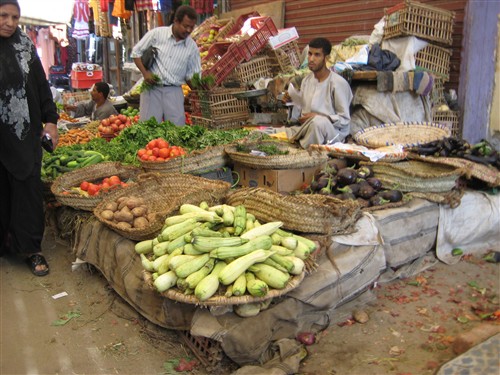 As our carriage pulled away from the local market, I conceived the idea of going back to the market the next day on foot, with a camera and a pocketful of baksheesh to see what kind of pictures we could get. The guys were on board with it so we spent that evening and the next morning working to break our bills into smaller denominations. Thanks to the Aaron and Andrew’s uncanny sense of direction, we found our way back to the street and the market was bubbling with activity. I should also note that I dressed more appropriately for the occasion and we all felt immensely more comfortable. The people were engaged in their daily business of buying and selling so, while we drew the typical “gringo” stares to which we have grown accustomed, less people actually approached us. For whatever reason, we did not disrupt the flow of activity to ask for photos but rather held our cameras inconspicuously low and snapped a few great shots of the interactions. As we reached the far end of the street, we began to turn down another alley that would lead us back into the market for another lap. As we started down the alley, we were engaged by a group of young girls who began following us and, despite our best efforts to thwart them, craftily enticed us into sparse conversation. The further we walked, the more they began to merge themselves with us, the stickier they became. If we tried to take a photo of something or someone, they would scamper into the shot and there were too many of them to manage. I found myself wanting to swat them like flies, to hiss at them, anything to shoo them away. With their scheming little black eyes, they seemed more like animals, like vultures, than children. Innocence has faded from the hardship they have already known in their young lives. As we came to the collective realization that our situation was not going to improve, we gave up and turned to walk back the other way. The little leaches followed us, of course. The ringleader (the oldest of the group; probably eight or nine years old) stuck to my side and continued to gradually crescendo her magnitude of annoyance. Both Andrew and Aaron were carrying backpacks and, while I had been walking with my purse clutched and my arms tightly against my pockets of baksheesh, I randomly glanced back to catch one of the smaller scamps trying to open Andrew’s backpack. I sternly swatted her grubby little claw away and, when I realized that their strategy was to steal, I firmly swiped my hand between the ringleader and myself and, in a raised voice said “NO”! As long as I live, I think I will never forget her response. She raised her petite four-foot frame, pointed a scrawny, brown finger in front of my face and, in the evil, muted tone of a gypsy’s curse, said “Be careful, Madam. Be careful”.
As our carriage pulled away from the local market, I conceived the idea of going back to the market the next day on foot, with a camera and a pocketful of baksheesh to see what kind of pictures we could get. The guys were on board with it so we spent that evening and the next morning working to break our bills into smaller denominations. Thanks to the Aaron and Andrew’s uncanny sense of direction, we found our way back to the street and the market was bubbling with activity. I should also note that I dressed more appropriately for the occasion and we all felt immensely more comfortable. The people were engaged in their daily business of buying and selling so, while we drew the typical “gringo” stares to which we have grown accustomed, less people actually approached us. For whatever reason, we did not disrupt the flow of activity to ask for photos but rather held our cameras inconspicuously low and snapped a few great shots of the interactions. As we reached the far end of the street, we began to turn down another alley that would lead us back into the market for another lap. As we started down the alley, we were engaged by a group of young girls who began following us and, despite our best efforts to thwart them, craftily enticed us into sparse conversation. The further we walked, the more they began to merge themselves with us, the stickier they became. If we tried to take a photo of something or someone, they would scamper into the shot and there were too many of them to manage. I found myself wanting to swat them like flies, to hiss at them, anything to shoo them away. With their scheming little black eyes, they seemed more like animals, like vultures, than children. Innocence has faded from the hardship they have already known in their young lives. As we came to the collective realization that our situation was not going to improve, we gave up and turned to walk back the other way. The little leaches followed us, of course. The ringleader (the oldest of the group; probably eight or nine years old) stuck to my side and continued to gradually crescendo her magnitude of annoyance. Both Andrew and Aaron were carrying backpacks and, while I had been walking with my purse clutched and my arms tightly against my pockets of baksheesh, I randomly glanced back to catch one of the smaller scamps trying to open Andrew’s backpack. I sternly swatted her grubby little claw away and, when I realized that their strategy was to steal, I firmly swiped my hand between the ringleader and myself and, in a raised voice said “NO”! As long as I live, I think I will never forget her response. She raised her petite four-foot frame, pointed a scrawny, brown finger in front of my face and, in the evil, muted tone of a gypsy’s curse, said “Be careful, Madam. Be careful”.
Shortly thereafter, we lost them and as we made our way back to the hotel, Andrew discovered that the little monsters had unsnapped the clasp of his money belt, which contained his credit cards and cash and remained concealed beneath his clothes. This seemed an unfathomable feat for such young crooks. Had they actually succeeded in the removal of his belt without his notice, it would have been an expensive and inconvenient casualty…but we would have to give the little thieves credit. They are good at what they do!
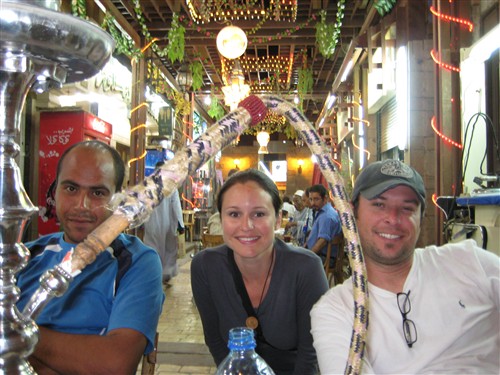
Our last two days in Luxor have been relatively peaceful and uneventful. Our tours came to an end and we sadly parted ways with Andrew, who headed back to Cairo on the overnight train. It was rejuvenating to have a couple of days with no itinerary and, now rested and recharged, we are flying to Sharm el-Sheikh and then driving to Dahab tonight for some scuba diving and beach time on the Red Sea. Time for Tina to get her fins wet…FINALLY!!!
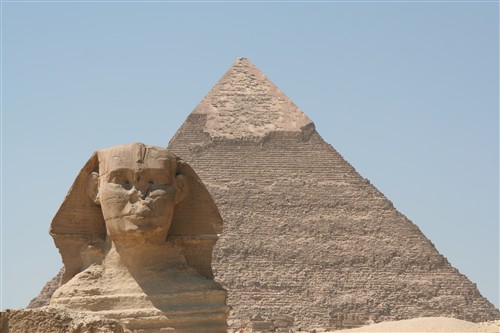 So you finally get situated in your room on your “Five Star” Nile River cruise ship. You’re rank and sweaty from three full days of touring ruins in the dusty, of the Sahara Desert, the stink of the camel is marinating in your clothes. You’ve been dreaming about nothing but a hot shower for days since your last hostel had no hot water and the overnight train to Aswan had no shower at all (not that you would have gone there anyway) so you peel off your ripened duds and turn the hot water dial and brown water comes pouring out. What do you do?
So you finally get situated in your room on your “Five Star” Nile River cruise ship. You’re rank and sweaty from three full days of touring ruins in the dusty, of the Sahara Desert, the stink of the camel is marinating in your clothes. You’ve been dreaming about nothing but a hot shower for days since your last hostel had no hot water and the overnight train to Aswan had no shower at all (not that you would have gone there anyway) so you peel off your ripened duds and turn the hot water dial and brown water comes pouring out. What do you do?
“Welcome to Egypt!” said the seemingly hospitable gate attendant at the Pyramids of Giza as he hurriedly popped the tops off of two lukewarm bottles of soda (which we didn’t want) and handed them up to us on our camels. “Here is a (tourist junk, thirty-for-a-penny plastic) scarab for good luck and bend down so that I can put a white sheet on your head to protect you from the intense Egyptian sun”. Caught off-guard and more than slightly out of our element, we hesitantly obliged. This once seemingly gracious man began to aggressively demand a ridiculous sum of money and when he only got nine Egyptian pounds (less than $2 US) out of us, he demanded his sheets back and angrily walked away. That was how we learned the crucial lesson that nothing in Egypt is free.
Welcome to Egypt! Where every man and boy is after the same tourist dollar and everyone wants “baksheesh” or tip over and above the price that you’ve already negotiated for a service. This is the urban jungle of Africa, where the Nile vitalizes miles of lush, green coastal cities and rural villages some thousands of years old but the lands beyond are desolate, lifeless desert. These ancient cities along the Nile boast some of the oldest and most magnificent temples and artifacts in the world and the Egyptians are capitalizing on all of them. Poverty is rampant and, as a tourist, you are constantly approached by a man or child trying to sell you some worthless trinket or a ride somewhere or a bottle of water that has been sitting in the sun all morning. The others simply say, “Hello! Money? Baksheesh?” I have to keep reminding myself that these people live hand to mouth and they are willing to do whatever is necessary, without regard for self-respect or decency, to sustain their lives. When your children are starving, there is no such thing as decency, no matter where you are.
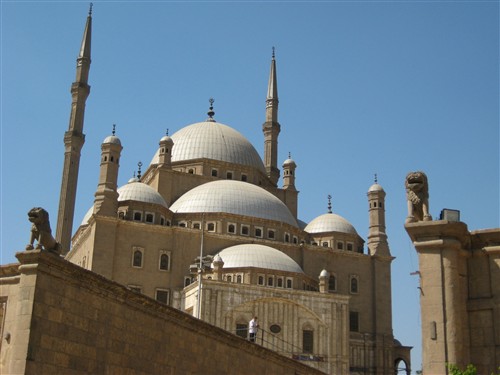 We had been moderately concerned about traveling to Egypt during Ramadan, the fourth pillar of Islam, in which observant Muslims fast from both food and drink (and sex and smoking) from 4:00am to 6:05pm each day for 30 days. Approximately ninety-percent of Egyptians are Muslim and also, according to our trusty guide book, it is frowned upon to eat or drink in public during these strict fasting hours. The unforgiving sun drives temperatures upwards of 100 degrees in September so the mere thought of spending whole days touring desert ruins with no water sounded dreadful but since we had already bought the tickets to Cairo, we decided to go. We have had no regrets! In fact, being here to witness such an important facet of Islamic tradition has added a new level of religious education to our experience.
We had been moderately concerned about traveling to Egypt during Ramadan, the fourth pillar of Islam, in which observant Muslims fast from both food and drink (and sex and smoking) from 4:00am to 6:05pm each day for 30 days. Approximately ninety-percent of Egyptians are Muslim and also, according to our trusty guide book, it is frowned upon to eat or drink in public during these strict fasting hours. The unforgiving sun drives temperatures upwards of 100 degrees in September so the mere thought of spending whole days touring desert ruins with no water sounded dreadful but since we had already bought the tickets to Cairo, we decided to go. We have had no regrets! In fact, being here to witness such an important facet of Islamic tradition has added a new level of religious education to our experience.
We arrived in Cairo at 1:30am and managed to secure a couple of visas and a taxi ride to the King Tut Hostel in downtown Cairo. As we were waiting in line to enter the country, I noticed a sign on the wall, warning that drug offenses perpetrated in Egypt are punishable by life in prison and, in some cases, death by hanging. I had to read it about ten times to truly comprehend its underlying meaning: “we’re not in Kansas anymore”! We are in Africa! Wild, raw, exotic Africa! The city is very much alive for the wee hours of the morning. We later learned that during Ramadan, the people break their fast at 6:05pm and then create a kind of festival in the streets until it’s time to begin the fast again at 4:00am. The men sit in groups outside small storefronts until sunrise, playing games, smoking sheesha, and conversing, and the whole city is illuminated!
The King Tut Hostel occupies the eighth floor of an old building that looks like it was once a large hotel or office space. We pushed the button for the elevator to be sent down and after about ten anxious minutes, it came down and we rode up in a wooden box of a lift that looked like an old dumbwaiter. We had been flying through the night and wanted nothing more than to slip into bed but our host at the hostel was eager to offer us tea and help us plan our entire Egypt trip…and book it through the hostel, of course. We decided to book our first two days of tours to check it out. Our guide, Mohammed, picked us up the next day to show us the Egyptian Museum, the Citadel, and the Hanging Church. There is intense competition in the tourism industry so the stewards are extremely knowledgeable and accommodating. Our tours were private – just the two of us, Mohammed, and a driver – and the car was surprisingly nice and new with leather interior and a/c, which seems to be rare around here. Most of the vehicles are old and beaten up because the driving in Cairo is CRAZY!!! Aaron aptly described it as “organized chaos”. There are few lights and no lanes and the streets are packed with cars whose drivers all honk incessantly and change lanes by sticking the noses of their vehicles into small openings in traffic and hitting the gas. Pedestrians – even children – walk fearlessly through the madness, bobbing and weaving, and somehow emerge safely on the other side of the street. The guide book strongly suggests finding an Egyptian who is crossing the street at the same time and using him as a human shield and that’s exactly what we did to survive in Cairo.
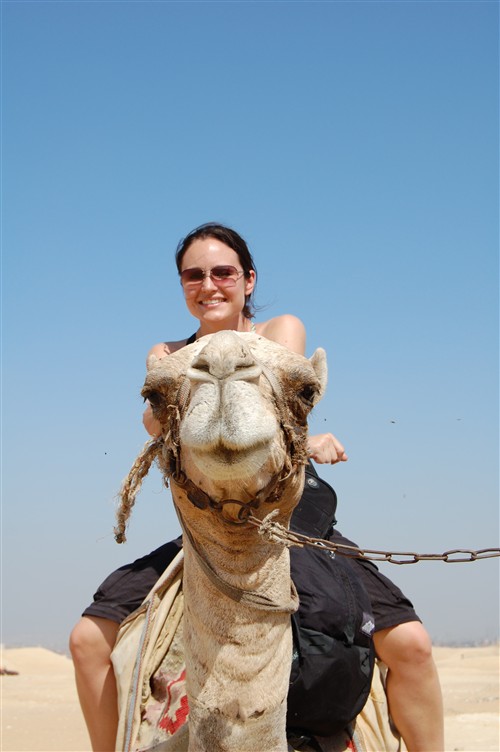 On our second day of touring, we saw the Pyramids and the Sphinx. Mohammed suggested that we see these by camel and he took us to the camel and horse stable, where the stable owner successfully negotiated an exorbitant price, using the animated intimidation tactics of his home court advantage. The man jumped around and scratched calculations into the dirt with a rock but his most convincing gesture was his fierce and penetrating stare into the depths Aaron’s soul. While we had every opportunity to walk away, we were mesmerized by the dramatic showmanship displayed in this tiny square of the world and we succumbed to the hypnotic guiles of this crafty negotiator. Satisfactorily mounted atop our trusty camels, Alibaba and Kilobanana, we set off for the Pyramids led by our camel guide, another Mohammed. It is important to note here that a camel ride is more of a box to be checked during African travel than a luxurious or comfortable experience. The ride is bouncy and, to my unwitting surprise, camels don’t just walk – they trot and canter! Holding on for dear life, we galloped into the desert and snapped some great pictures at the Pyramids. When we returned to the stable, dust-covered and chafed, we were happy to bid farewell to Alibaba and Kilobanana, who hopefully enjoyed a large trough of water after we left.
On our second day of touring, we saw the Pyramids and the Sphinx. Mohammed suggested that we see these by camel and he took us to the camel and horse stable, where the stable owner successfully negotiated an exorbitant price, using the animated intimidation tactics of his home court advantage. The man jumped around and scratched calculations into the dirt with a rock but his most convincing gesture was his fierce and penetrating stare into the depths Aaron’s soul. While we had every opportunity to walk away, we were mesmerized by the dramatic showmanship displayed in this tiny square of the world and we succumbed to the hypnotic guiles of this crafty negotiator. Satisfactorily mounted atop our trusty camels, Alibaba and Kilobanana, we set off for the Pyramids led by our camel guide, another Mohammed. It is important to note here that a camel ride is more of a box to be checked during African travel than a luxurious or comfortable experience. The ride is bouncy and, to my unwitting surprise, camels don’t just walk – they trot and canter! Holding on for dear life, we galloped into the desert and snapped some great pictures at the Pyramids. When we returned to the stable, dust-covered and chafed, we were happy to bid farewell to Alibaba and Kilobanana, who hopefully enjoyed a large trough of water after we left.
Though Cairo is teeming with automobiles, the use of animal power is still very common. There is an abundance of donkey carts, camels, and horse drawn carriages, which carry loads of fresh vegetables, papyrus, and various other wares. For such an ancient culture, it seems so primitive, which adds to its intrigue. The style of dress is also fascinating. The most common male attire is a long-sleeved, ankle-length shirt dress (called “galabiyya”) that is lightweight, flowing and looks incredibly comfortable and appropriate for the hot climate. Many also wear turbans. Egyptian women remain a mystery to us. We see very few of them on the streets and the ones we do see are covered from head-to-toe, excluding the face, or donning the traditional “khemar” (which is all black and covers the whole face except the eyes) and usually following, with down-turned, oppressed eyes, obediently, reverently behind a man. We are told that the women choose to cover themselves in this way. It would take a much longer and more intense period of observation to make our own educated determination. In a culture where women do not have equal rights, my American-born instincts tell me that women would not choose to cover themselves from head to toe without generations of severe consequences for disobedience. This is a culture that is thousands of years old and I cannot even begin to scratch the surface of understanding.
A few nights ago in Cairo, we headed out in search of dinner after a hot afternoon of sightseeing. Our guide book had suggested dinner at a place downtown, called the Greek Club, but finding our way there proved most difficult because of the markings on the streets or lack thereof. Two middle-aged Nubian gentlemen collected us and walked us to a place that they recommended for traditional fare, a place called Alfy Bey. We were uncertain walking in but our hunger and thirst greatly outweighed our uncertainty so we took a table. At this hour, about 5:00pm, the restaurant was quite empty, except for two or three tables. The menu had both English and Arabic descriptions so we were able to decipher a bit of it, though ordering was analogous to diving face first off a cliff. Luckily, the water was fine and the food was excellent. We ate spiced veal and braised lamb with assorted dolmas and plates of pita, hummus, tahini, and a spicy tomato salsa. Interestingly, the Muslims began to file in and take seats around 5:30 and soon the restaurant was filling up. I watched the wait staff delivering drinks, salads, and steaming platters of meats, rice and vegetables to the tables of the Muslim patrons; however, the food and drinks remained untouched. The people were waiting for the clock to strike 6:05 so that they could break fast. They were contentedly smiling and chatting over the aromatic dishes, seemingly oblivious to the scrumptious temptations right under their noses. The Herculean strength of the will power of faith is both frightening and humbling! We finished our meal, paid our bill, and were rather abruptly asked to relinquish our table in time for someone’s Ramadan feast. We didn’t mind because we were finished, happily fed and weary from our long day so we stepped back out onto the streets, which were now crowded with outdoor seating and people everywhere, all seemingly in a festive mood.
We decided to book the remainder of our Egypt tour through the King Tut Hostel. This is a difficult country in which to independently navigate your way and we decided that it was worth the premium to have our transportation and accommodations arranged. Everything is still private but we have come all the way to Egypt and found a Texan! Andrew Leonard lives the Dallas area and was traveling solo but the three of us have been inseparable. We took the overnight train (13 hours) to Aswan. Our first class cabins had a row of three seats, which folded into a bed and there was another bunk bed above. There was a small sink in each cabin but a common restroom (water closet, as it is called here) and we quickly discovered that the toilet opened right onto the train tracks! Our passage included dinner and breakfast and we rested well, except for the abrupt movements of the train which periodically jarred us from sleep. In Aswan, we were transferred to our Nile River cruise ship, the M/S RA. Our rooms were not yet ready so we hired a felucca and set sail on the river. The felucca was pleasant with the shade of its canopy, the view of the river banks lined with date palms and papyrus, and the hazy, gentle breeze. We returned to the ship and checked into our rooms. As I entered the bathroom and turned the dial, I longed for a hot shower as if it were a desert oasis and when the steaming brown water came rushing down, I stood bug-eyed for a moment and then thanked God for the hot brown shower and hopped in. We are in passionate pursuit of experience in the art, architecture, culture, industry, landscapes and waterscapes of the world. An occasional brown shower and many other small sacrifices of comfort along the way are unavoidable and we are happy to endure them for the privilege of this journey.
 We crawled out of bed at 2:45 the next morning for a half-day trip by minibus to Abu Simbel to see the colossal temples of Ramses II and his wife Nefertari. Mohammed explained that the construction of the Great Temple of Ramses II (built between 1274 and 1244 BC) is fascinating for two reasons. First, there are four enormous statues of Ramses II, carved into the stone entrance and the sheer size of these magnificent statues is jaw-dropping as you round the corner to the temple’s entrance. Inside there are several cavernous rooms, adorned with stone columns, more giant statues of Ramses II, and floor-to-ceiling etchings of ancient battle scenes portraying Ramses II slaying his enemies and making offerings to various Egyptian Gods in the afterlife. Even more remarkable is that the precise alignment of the temple is such that, on February 22 and October 22 (the day of Ramses birth and of his coronation) each year, the first rays of the morning sun shine on the faces of three of the four statues of Egyptian Gods carved in the innermost sanctuary of the temple. The fourth statue of the God Ptah is not illuminated on these two dates because Ptah is the God of Darkness. We are utterly bewildered by the advanced degree of calculation and measurement involved in such a feat that was achieved over three thousand years ago!
We crawled out of bed at 2:45 the next morning for a half-day trip by minibus to Abu Simbel to see the colossal temples of Ramses II and his wife Nefertari. Mohammed explained that the construction of the Great Temple of Ramses II (built between 1274 and 1244 BC) is fascinating for two reasons. First, there are four enormous statues of Ramses II, carved into the stone entrance and the sheer size of these magnificent statues is jaw-dropping as you round the corner to the temple’s entrance. Inside there are several cavernous rooms, adorned with stone columns, more giant statues of Ramses II, and floor-to-ceiling etchings of ancient battle scenes portraying Ramses II slaying his enemies and making offerings to various Egyptian Gods in the afterlife. Even more remarkable is that the precise alignment of the temple is such that, on February 22 and October 22 (the day of Ramses birth and of his coronation) each year, the first rays of the morning sun shine on the faces of three of the four statues of Egyptian Gods carved in the innermost sanctuary of the temple. The fourth statue of the God Ptah is not illuminated on these two dates because Ptah is the God of Darkness. We are utterly bewildered by the advanced degree of calculation and measurement involved in such a feat that was achieved over three thousand years ago!
Our “five star” cruise ship is far from luxurious, two stars at most by American standards, but we have enjoyed our cruise nonetheless. Gliding down the Nile brings a wave of tranquility over us and we have spent most of our time on the sun deck: reading, writing, snoozing, talking and watching with fascination the life along the river banks. The tribal women are washing their clothes, pots and utensils in the (notoriously polluted) river while the farmers are loading the backs of their donkeys with reeds of papyrus and other crops. They fish and sow the land and live on the fruits of their labors. Farming seems an unimaginably hard way of life but I think that the daily communion with the land must cultivate the soul to its richest purity.
The ship docked for several hours in what we initially thought was the West Bank of Luxor. Hungry for a little adventure, the three of us decided to take a walk through the town. I should interject here that until now, we had stayed primarily in tourist areas and while the traditional Egyptian dress code is the polar extreme of conservative, the standard is relaxed in the tourist spots and we flesh-baring foreigners can safely wear our shorts and t-shirts. Thinking that we were in the tourist town of Luxor and having spent days on the cruise ship, I unwittingly exited the boat in capris and a little spaghetti strap top. I would soon realize my error in judgment. Luxor is often coined the “hassle capital of Egypt” and we braced ourselves for a more intense magnitude of harassment. The moment that we arrived on the shore, we were approached for a horse carriage ride, which we firmly declined. The driver proceeded to follow us down the road, trying to negotiate a continually decreasing fare but to no avail. Then a group of young boys began to follow us, begging for a pound, just one English pound! The children are fascinating; they are persistent and savvy in their pursuit of a handout. They speak fragments of about eight languages and try to engage you by greeting you in all eight tongues to see which one is yours.
 As we turned to walk deeper into the town, we came upon a small street market on a poverty-stricken stretch of dirt road. The stalls were lined with fruits and vegetables, spices in heavy burlap sacks, clothing, shoes and miscellaneous household wares. There were motorcycles, bicycles, donkey carts and goats on the road and the stench of filth and feces invaded our nostrils; it was the smell of true poverty. As a woman opened her door and dumped a bucket of who-knows-what into the middle of the road, Aaron noticed the dim light and dirt floor of the interior. There were no tourists here and we drew the stares of every man, woman and child as we hesitantly walked, wondering what exactly we were getting ourselves into. The harassment continued for the entire length of our walk with hawkish stares, honks, whistles and unmistakably derogatory Arabic and English comments, mostly directed at me. The adult men stared their fierce, penetrating, stares while the children aggressively taunted us, a few times throwing rocks at our backs. The rural women, even more conservatively dressed than in Cairo, looked at us in wonderment and then quickly averted their eyes and moved on.
As we turned to walk deeper into the town, we came upon a small street market on a poverty-stricken stretch of dirt road. The stalls were lined with fruits and vegetables, spices in heavy burlap sacks, clothing, shoes and miscellaneous household wares. There were motorcycles, bicycles, donkey carts and goats on the road and the stench of filth and feces invaded our nostrils; it was the smell of true poverty. As a woman opened her door and dumped a bucket of who-knows-what into the middle of the road, Aaron noticed the dim light and dirt floor of the interior. There were no tourists here and we drew the stares of every man, woman and child as we hesitantly walked, wondering what exactly we were getting ourselves into. The harassment continued for the entire length of our walk with hawkish stares, honks, whistles and unmistakably derogatory Arabic and English comments, mostly directed at me. The adult men stared their fierce, penetrating, stares while the children aggressively taunted us, a few times throwing rocks at our backs. The rural women, even more conservatively dressed than in Cairo, looked at us in wonderment and then quickly averted their eyes and moved on.
We wanted desperately to photograph everyone and everything in this place, to capture the untamed spirit of the people but we were honestly too afraid to take out our cameras. Everyone wants baksheesh and you can’t seem to get small bills anywhere. The ATMs spit out hundreds. The eyes of Egyptian men look through you, intimidating and preying on your innermost vulnerability. You don’t know what is in their hearts and minds but their piercing stares imply suspicion, distrust and hatred. The uneasiness in our gait only fed their hunger for our fear. We handled the situation with poise, ignoring the insults and the rocks, walking around the people who stepped in front of us and remaining guarded and cognizant of the volatility of our environment. Near the end of the road, we spotted a hand-painted sign for the “Politie Esna” or Esna Police. We had only been a couple of streets from the dock in the port town of Esna but we felt like we were in another world. No photograph or story could truly capture the adrenaline rush, the sheer exhilaration of that experience but the vivid memory of it will stay with us for a very long time.
Posted under Europe & Netherlands
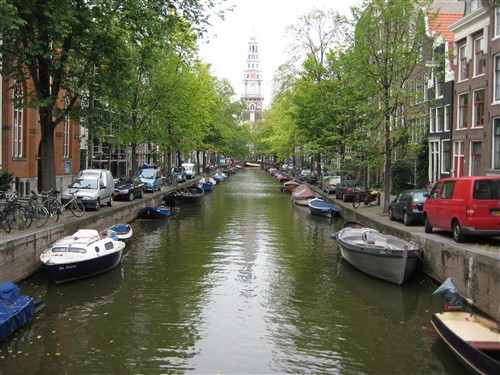
The relaxing four-hour train ride provided a good mental transition from bustling Paris to Bohemian Amsterdam. We arrived at Centraal Station in the early afternoon and, after a few tense moments of trying to locate our tram stop and (unsuccessfully) the whereabouts of Aaron’s Ray Bans, we made our way to the address of the room that we’d booked for the next five nights. To our surprise, the address was residential so after checking and re-checking our notes, Aaron hesitantly rang the bell and was greeted by a smiling woman who introduced herself as Henriette. As it turned out, we had unknowingly rented a spare room in someone’s home and it is absolutely charming! The house is a narrow, brick four-story, we think owned by Henriette’s delightful mother, Jes (I’ve been calling her “the Dutch Yiayia” because she reminds me of my own beloved Yia) who lives on the ground floor in the rooms next to ours.
Henriette and her siblings live in the three floors of apartments above with their respective families. How cozy! Our room gets its distinct charm from the Nordic antique furniture: dainty, delicate wood chairs upholstered in red-and-cream-striped silk, a gorgeous wooden built-in closet and marble-topped nightstands and artsy accents. There are “little hippy” touches too – the kaleidoscope curtains and psychedelic bed cover and they quaintly contrast while strangely complementing the antique décor. The Dutch Yiayia is a lovely hostess and has stocked a small pantry with an electric hot water pot, utensils, glassware and dishware for two as well as an assortment of instant coffee, teas, candies and cup-o-soup packets. Each morning, after we leave, she comes in and washes all of our dishes and takes out our trash (and refills the chocolates because we eat them all every day). When we first met her, we inquired about the nearest laundry facility and she offered to let us use her washing machine. The next morning, she was going to show us how to use it but we weren’t supposed to knock on her door because she sleeps late. We gathered our pile of laundry on the bed and went out for few hours. When we returned, our clothes were washed and hanging neatly on a drying rack in the foyer. This little lady has melted our hearts with her warmth and endearing sweetness. You meet her and you just want to hug her! She’s so cool. This has been the best place that we’ve stayed so far; it has felt like a home on the road!
Amsterdam and Holland are famous for a lot of things – canals, tulips, wooden clogs, cannabis-selling “coffee shops” and, of course, the Red Light district. There are also museums, high-end boutiques and outdoor cafés, and hundreds of years of history in this one-time capital of Europe. We’ve spent a lot of time walking around this very compact city, sitting in cafés, observing locals and tourists alike. Having been in Amsterdam for five days, it’s hard not to notice some things that we’re simply not used to seeing.
 First, a little drug education: Probably most famous are the “coffee shops” that dot the streets in the greater metropolitan area. At these local purveyors of higher enlightenment, any one over the age of 18 can walk in and order his/her choice of cannabis or hashish from an extensive menu with selections from around the world. The process is similar to ordering a bottle of wine at a nice restaurant, where the knowledgeable sommelier is happy to impart the differences among the many varieties available. You can order pre-rolled joints or in bulk quantities by the gram and a side of paraphernalia if you please. If an establishment calls itself a “café”, then you cannot buy or smoke “soft drugs” there. If it says “coffee shop” on the sign, then you are sure to inhale an aromatic, evergreen-like, inviting soft smoke wafting out of its doorway. These establishments do not sell alcohol but have an otherwise enticing selection of coffees, teas, and fruity concoctions for the amplified taste buds of their patron stoners.
First, a little drug education: Probably most famous are the “coffee shops” that dot the streets in the greater metropolitan area. At these local purveyors of higher enlightenment, any one over the age of 18 can walk in and order his/her choice of cannabis or hashish from an extensive menu with selections from around the world. The process is similar to ordering a bottle of wine at a nice restaurant, where the knowledgeable sommelier is happy to impart the differences among the many varieties available. You can order pre-rolled joints or in bulk quantities by the gram and a side of paraphernalia if you please. If an establishment calls itself a “café”, then you cannot buy or smoke “soft drugs” there. If it says “coffee shop” on the sign, then you are sure to inhale an aromatic, evergreen-like, inviting soft smoke wafting out of its doorway. These establishments do not sell alcohol but have an otherwise enticing selection of coffees, teas, and fruity concoctions for the amplified taste buds of their patron stoners.
The ambience inside is a collaboration of dim lights, smoky haze and psychedelic melodies. People are happy and relaxed, peacefully celebrating the liberties they have only in this liberated city, where soft drug use is viewed as a health issue rather than a criminal issue. Interestingly, Amsterdam also boasts a number of “Smartshops”, which sell fresh psychedelic mushrooms and truffles. These come in as many “flavors” as marijuana and the legal distinction is this: fresh mushrooms are considered to be in the “grey area” between soft drugs and hard drugs. The process of drying converts them to hard drugs so, even though the euphoric effects are similar between the fresh and dried versions of these trippy vegetables, Smartshops can legally sell the fresh while the dried are illegal. That said, the public cigarette smoking in both Paris and Amsterdam is much more offensive than any of the above-mentioned vices. Next summer, when we’re back in Europe, we’ll have to remember to pack our gas masks.
Second is the omnipresent testosterone vibe that permeates this city. For the numerous young adult male entourages (seemingly the most prevalent demographic) who come here to sow their young oats and experience the wild life, there are many temptations, besides legal drugs, to gain their attentions. The Gentlemen’s clubs and pornographic cinemas advertising live sex shows and other perversities, the numerous erotica stores, and the infamous Red Light District draw them into a world of Godless indulgence. As it is our goal on this trip to see the world, in all of its beauty and ugliness, we took the tram into the Red Light District on Saturday night to observe it during its highest magnitude of bustling activity.
The streets were packed with an odd mix of gawking tourists, curious young couples, and the aforementioned groups of males on the prowl. The streets of the district are intermixed with pubs, Gentlemen’s clubs, and, of course, the Red Light women of the world’s oldest profession. The unfortunate women of all nationalities, young and beautiful in skimpy lingerie, smile and sway in their windows, ignoring the gawking tourists, waiting for a customer to come in and take another little piece of their souls. It pains us to look too long at them…pretty caged birds. We want to save them but it is a lost cause. Each window has a red light above it. If the red light is on, and the curtain is closed, it means a customer is being serviced. If the red light is off, then no one is working that window at the moment. This environment invariably brings to light the worst faces of men. In their drunkenness and testosterone-inflated states of mind, they taunt the birds in their cages and shout obscenities at them but these birds are tough, hardened by the circumstances of life which have dealt them their current lot, and they fire back with verbal atrocities that ring through the streets. As we were passing by, one of the women opened her door and threw water and insults at a man on the street, which splashed us also. She quickly apologized to us and shut herself back in…two minutes later, she was back to smiling and swaying. Tough birds.
 Finally, as in most large cities there are of people hurriedly rushing around from one place to another, but in Amsterdam they are all on fiets (bikes). We have never seen so many bikes in our entire lives! There are approximately 800,000 people living in Amsterdam and an estimated 600,000 bikes. Bicycle-riding is truly a way of life for the Dutch. Men wearing suits and women in beautiful flowing dresses ride next to cell phone-holding students and mothers with children in seats on the front handlebars and back wheel. As a pedestrian, you are much more likely to be hit by a bicycle than a car! Bicycles dominate the landscape here, so we decided to see what it’s really like to be a fietser (cyclist) in Amsterdam.
Finally, as in most large cities there are of people hurriedly rushing around from one place to another, but in Amsterdam they are all on fiets (bikes). We have never seen so many bikes in our entire lives! There are approximately 800,000 people living in Amsterdam and an estimated 600,000 bikes. Bicycle-riding is truly a way of life for the Dutch. Men wearing suits and women in beautiful flowing dresses ride next to cell phone-holding students and mothers with children in seats on the front handlebars and back wheel. As a pedestrian, you are much more likely to be hit by a bicycle than a car! Bicycles dominate the landscape here, so we decided to see what it’s really like to be a fietser (cyclist) in Amsterdam.
“Hell on Wheels” as told by Aaron:
We rented a couple of heavy, steel-framed, fixed-gear bikes from a local outfit named Mike’s Bike Tours. After some paperwork and quick instruction on how to lock them, we were off on an adventure to explore the countryside and towns north of Amsterdam with only a rough Lonely Planet map in tow. Tina has been fighting a head cold but agreed begrudgingly to go along, knowing how much it would mean to me. We spent the next 10 minutes working our way through the city traffic, coming within six inches of getting clobbered by a tram, and arrived at the ferry dock just behind Centraal Station. Taking a ferry across the waterway and setting off just after 10am with an expected high temperature of 70 degrees and a light breeze out of the South, it was a seemingly perfect day for riding. Almost immediately after disembarking the ferry we got lost and quickly discovered that while many people in Amsterdam speak fluent English, the Dutch people outside of Amsterdam did not. We finally found our way and although we were now riding our original planned loop in reverse, we were happy to be on our way. The sturdy, 30-pound bikes were like beach cruisers, not extremely comfortable or aerodynamic for a long ride, and the seat began almost immediately to chafe me in all of the wrong places. But we were riding through the Dutch countryside, through centuries-old towns and cobblestone streets, across rustic wooden bridges and adjacent to reed-studded canals, lined with small wooden boats, and lush green fields with grazing jersey cows and sheep. It’s easy to see how so many great artists were inspired by these tranquil, rolling landscapes.
 After stopping for lunch at a small café in Broek in Waterland, we continued on our journey through a number of small towns, occasionally taking wrong turns but eventually making our way to the center of Edam, our final destination about 25km northeast of Amsterdam. Many local bike tour companies do group tours to the town of Edam with stops at cheese and clog-making factories along the way, so we thought that it might be worth a visit ourselves. It was a quaint, historic town with the original construction of narrow brick lanes and small brick shops lining the canals that snaked through the village. After a brief stroll, we began the long ride back which, unbeknownst to us at the time, would transform our leisurely countryside bicycle ride into “Hell on wheels”. We noticed that the wind had begun to pick up from the light breeze earlier in the morning to sustained high winds with strong gusts and we were now facing it head on. As a cyclist I’m used to riding into the wind but riding a single speed bike that weighs twice as much as my bike back home into a constant headwind was not fun. And it was about to get worse.
After stopping for lunch at a small café in Broek in Waterland, we continued on our journey through a number of small towns, occasionally taking wrong turns but eventually making our way to the center of Edam, our final destination about 25km northeast of Amsterdam. Many local bike tour companies do group tours to the town of Edam with stops at cheese and clog-making factories along the way, so we thought that it might be worth a visit ourselves. It was a quaint, historic town with the original construction of narrow brick lanes and small brick shops lining the canals that snaked through the village. After a brief stroll, we began the long ride back which, unbeknownst to us at the time, would transform our leisurely countryside bicycle ride into “Hell on wheels”. We noticed that the wind had begun to pick up from the light breeze earlier in the morning to sustained high winds with strong gusts and we were now facing it head on. As a cyclist I’m used to riding into the wind but riding a single speed bike that weighs twice as much as my bike back home into a constant headwind was not fun. And it was about to get worse.
Our original plan was to ride a counter-clockwise loop through several country villages, then return to Amsterdam. However because we started off in the wrong direction, we amended our plan to now complete the loop going clockwise. What we failed to realize was that the last leg of the loop, a distance of about 15km, would be along the coast of a huge lake atop a dyke that was completely exposed, heading south directly into the wind. We pedaled along at a snail’s pace, occasionally dismounting and walking because our legs were burning and the wind was so fierce that we could no longer make the pedals turn. After what seemed an eternity of pedaling, a lot of cursing (mostly by Tina), and sour attitudes all around, we made it back to the shelter of town and miraculously found the ferry dock on our first try. We returned to the center of Amsterdam, fighting the pedestrian and car traffic, and eased our pain, both psychologically and physically, with steaming dishes of Italian pasta and pizza. Limping home, we both agreed that we had been a little over-ambitious about the 35-mile itinerary with our tank-like bikes. In hindsight I probably wouldn’t do it again, but it was my first long bike ride in almost four months and I feel like a fietser again.
Tomorrow evening, we leave for Cairo. Our adventure in Amsterdam has been fulfilling in a different way than Paris. We’ve spent our days and nights aimlessly wandering and exploring the city with no agenda but to take it all in. We did check out the Van Gogh museum; while the story of Van Gogh’s tortured soul was fascinating and his works divine, we still had the Louvre in our hearts and the little Van Gogh museum was less impressive (and ironically more expensive) in comparison. We spent one gorgeous sunny day barefoot in the park, where we witnessed some tone-deaf German (just guessing) adolescents singing off-key odes to Jesus and proceeding to “baptize” one of their members in the creek. We spent one chilly night in the warmth of our cozy room, talking for hours, listening to music, and overdosing on Dutch cup-o-soup. We have wandered along the canals and narrow, brick side streets and popped into cafes and coffee shops at random. Amsterdam is similar to Vegas in that it has a lot of guilty pleasures to offer the curious traveler but when it’s time to leave, you’re ready to go.
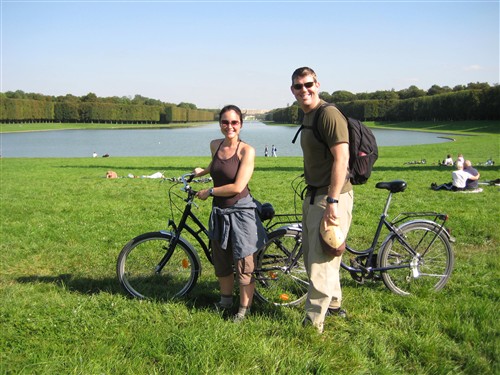
Versailles was magical! We began with a tour of the Chateau and its majestic salons and corridors. The muraled ceilings, the regal red and green silk wallpapers, the gold-embroidered bed coverings, and oil portraits of generations of royal bloodlines entice the imagination into romantic fantasies of inhabiting such celestial palaces. We dream our own faces into the marble busts atop the mantles and into the portraits of gents and demure dames in Renaissance gowns of velvet and lace, with pearly-white heaving bosoms. The Royal Apartments seem almost fictional as one cannot reasonably fathom a life in such luxurious excess.
The Hall of Mirrors incites pure delight with its glistening crystal chandeliers refracting colorful light from the floor-to-ceiling paned windows offering the best view of the Edenesque gardens below. The inner wall of the hall is aligned with gold-trimmed mirrors, creating the illusion of space and light. Also spectacular is the Hall of Battles, a long, lavish corridor lined with enormous oil paintings depicting centuries of French battle scenes. The tourist headsets are complimentary with the price of admission and we enjoyed listening to the recorded stories of many of the battles portrayed on these great walls.
And then there were the gardens! The sunny afternoon made for a gorgeous descent into the main garden, where the bright green lawn seems to end in the sky. We lounged in the grass along the edge of a cross-shaped canal and soaked up the sun, pondering the rental of a rowboat. The gardens were vast beyond the water, though, and at Aaron’s suggestion, we opted to take bikes instead. This turned out to be a brilliant choice as we spent the next glorious hour gliding along with the gentle breeze coolly carrying us through the autumn woods. As we merrily pedaled along, I felt a youthful freedom that I had not felt in years! It was exhilarating to feel suddenly devoid of inhibition, devoid of uncertainty and anxiety, and to be childishly, wholeheartedly, breathlessly living in that moment! Time stopped for us; it was a vision that will be safely tucked away among my fondest memories in that treasure chest of perfect moments.
